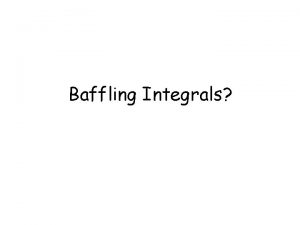15 Multiple Integrals Copyright Cengage Learning All rights





























- Slides: 29

15 Multiple Integrals Copyright © Cengage Learning. All rights reserved.

15. 7 Triple Integrals Copyright © Cengage Learning. All rights reserved.

Triple Integrals We have defined single integrals for functions of one variable and double integrals for functions of two variables, so we can define triple integrals for functions of three variables. Let’s first deal with the simplest case where f is defined on a rectangular box: B = {(x, y, z) | a x b, c y d, r z s} The first step is to divide B into sub-boxes. We do this by dividing the interval [a, b] into l subintervals [xi – 1, xi] of equal width x, dividing [c, d ] into m subintervals of width y, and dividing [r, s] into n subintervals of width z. 3

Triple Integrals The planes through the endpoints of these subintervals parallel to the coordinate planes divide the box B into lmn sub-boxes Bijk = [xi – 1, xi] [yj – 1, yj] [zk – 1, zk] which are shown in Figure 1. Each sub-box has volume V = x y z. Figure 1 4

Triple Integrals Then we form the triple Riemann sum where the sample point is in Bijk. By analogy with the definition of a double integral, we define the triple integral as the limit of the triple Riemann sums in (2). 5

Triple Integrals Again, the triple integral always exists if f is continuous. We can choose the sample point to be any point in the sub-box, but if we choose it to be the point (xi, yj, zk) we get a simpler-looking expression for the triple integral: 6

Triple Integrals Just as for double integrals, the practical method for evaluating triple integrals is to express them as iterated integrals as follows. The iterated integral on the right side of Fubini’s Theorem means that we integrate first with respect to x (keeping y and z fixed), then we integrate with respect to y (keeping z fixed), and finally we integrate with respect to z. 7

Triple Integrals There are five other possible orders in which we can integrate, all of which give the same value. For instance, if we integrate with respect to y, then z, and then x, we have 8

Example 1 Evaluate the triple integral B xyz 2 d. V, where B is the rectangular box given by B = {(x, y, z) | 0 x 1, – 1 y 2, 0 z 3} Solution: We could use any of the six possible orders of integration. If we choose to integrate with respect to x, then y, and then z, we obtain 9

Example 1 – Solution cont’d 10

Triple Integrals Now we define the triple integral over a general bounded region E in three-dimensional space (a solid) by much the same procedure that we used for double integrals. We enclose E in a box B of the type given by Equation 1. Then we define a function F so that it agrees with f on E but is 0 for points in B that are outside E. By definition, This integral exists if f is continuous and the boundary of E is “reasonably smooth. ” 11

Triple Integrals The triple integral has essentially the same properties as the double integral. We restrict our attention to continuous functions f and to certain simple types of regions. 12

Triple Integrals A solid region E is said to be of type 1 if it lies between the graphs of two continuous functions of x and y, that is, E = {(x, y, z) | (x, y) D, u 1(x, y) z u 2(x, y)} where D is the projection of E onto the xy-plane as shown in Figure 2. A type 1 solid region Figure 2 13

Triple Integrals Notice that the upper boundary of the solid E is the surface with equation z = u 2(x, y), while the lower boundary is the surface z = u 1(x, y). By the same sort of argument, it can be shown that if E is a type 1 region given by Equation 5, then The meaning of the inner integral on the right side of Equation 6 is that x and y are held fixed, and therefore u 1(x, y) and u 2(x, y) are regarded as constants, while f (x, y, z) is integrated with respect to z. 14

Triple Integrals In particular, if the projection D of E onto the xy-plane is a type I plane region (as in Figure 3), then E = {(x, y, z) | a x b, g 1(x) y g 2(x), u 1(x, y) z u 2(x, y)} and Equation 6 becomes A type 1 solid region where the projection D is a type I plane region Figure 3 15

Triple Integrals If, on the other hand, D is a type II plane region (as in Figure 4), then E = {(x, y, z) | c y d, h 1(y) x h 2(y), u 1(x, y) z u 2(x, y)} and Equation 6 becomes A type 1 solid region with a type II projection Figure 4 16

Triple Integrals A solid region E is of type 2 if it is of the form E = {(x, y, z) | (y, z) D, u 1(y, z) x u 2(y, z)} where, this time, D is the projection of E onto the yz-plane (see Figure 7). The back surface is x = u 1(y, z), the front surface is x = u 2(y, z), and we have A type 2 region Figure 7 17

Triple Integrals Finally, a type 3 region is of the form E = {(x, y, z) | (x, z) D, u 1(x, z) y u 2(x, z)} where D is the projection of E onto the xz-plane, y = u 1(x, z) is the left surface, and y = u 2(x, z) is the right surface (see Figure 8). A type 3 region Figure 8 18

Triple Integrals For this type of region we have In each of Equations 10 and 11 there may be two possible expressions for the integral depending on whether D is a type I or type II plane region (and corresponding to Equations 7 and 8). 19

Applications of Triple Integrals 20

Applications of Triple Integrals Recall that if f (x) 0, then the single integral represents the area under the curve y = f (x) from a to b, and if f (x, y) 0, then the double integral D f (x, y) d. A represents the volume under the surface z = f (x, y) and above D. The corresponding interpretation of a triple integral E f (x, y, z) d. V, where f (x, y, z) 0, is not very useful because it would be the “hypervolume” of a fourdimensional object and, of course, that is very difficult to visualize. (Remember that E is just the domain of the function f ; the graph of f lies in four-dimensional space. ) 21

Applications of Triple Integrals Nonetheless, the triple integral E f (x, y, z) d. V can be interpreted in different ways in different physical situations, depending on the physical interpretations of x, y, z and f (x, y, z). Let’s begin with the special case where f (x, y, z) = 1 for all points in E. Then the triple integral does represent the volume of E: 22

Applications of Triple Integrals For example, you can see this in the case of a type 1 region by putting f (x, y, z) = 1 in Formula 6: and we know this represents the volume that lies between the surfaces z = u 1(x, y) and z = u 2(x, y). 23

Example 5 Use a triple integral to find the volume of the tetrahedron T bounded by the planes x + 2 y + z = 2, x = 2 y, x = 0, and z = 0. Solution: The tetrahedron T and its projection D onto the xy-plane are shown in Figures 14 and 15. Figure 14 Figure 15 24

Example 5 – Solution cont’d The lower boundary of T is the plane z = 0 and the upper boundary is the plane x + 2 y + z = 2, that is, z = 2 – x – 2 y. Therefore we have (Notice that it is not necessary to use triple integrals to compute volumes. They simply give an alternative method for setting up the calculation. ) 25

Applications of Triple Integrals All the applications of double integrals can be immediately extended to triple integrals. For example, if the density function of a solid object that occupies the region E is (x, y, z), in units of mass per unit volume, at any given point (x, y, z), then its mass is and its moments about the three coordinate planes are 26

Applications of Triple Integrals The center of mass is located at the point where If the density is constant, the center of mass of the solid is called the centroid of E. The moments of inertia about the three coordinate axes are 27

Applications of Triple Integrals The total electric charge on a solid object occupying a region E and having charge density (x, y, z) is If we have three continuous random variables X, Y, and Z, their joint density function is a function of three variables such that the probability that (X, Y, Z) lies in E is 28

Applications of Triple Integrals In particular, The joint density function satisfies 29
 Copyright cengage learning. powered by cognero
Copyright cengage learning. powered by cognero Change of variables multiple integrals
Change of variables multiple integrals Copyright 2015 all rights reserved
Copyright 2015 all rights reserved Copyright © 2015 all rights reserved
Copyright © 2015 all rights reserved Dell all rights reserved copyright 2009
Dell all rights reserved copyright 2009 Copyright © 2018 all rights reserved
Copyright © 2018 all rights reserved 2009 delmar cengage learning
2009 delmar cengage learning Medical terminology chapter 5 learning exercises answers
Medical terminology chapter 5 learning exercises answers Cengage learning heart diagram
Cengage learning heart diagram South-western cengage learning
South-western cengage learning Chapter 13 medical math assignment sheet cengage learning
Chapter 13 medical math assignment sheet cengage learning 2009 delmar cengage learning
2009 delmar cengage learning Cengage learning heart diagram
Cengage learning heart diagram Medical terminology chapter 1 answers
Medical terminology chapter 1 answers Cengage learning australia
Cengage learning australia 2009 delmar cengage learning
2009 delmar cengage learning Whille
Whille Cengage learning
Cengage learning Wadsworth cengage learning
Wadsworth cengage learning Cengage learning
Cengage learning Cengage learning plant cell
Cengage learning plant cell Cengage learning
Cengage learning Cengage learning
Cengage learning Brooks cole cengage learning
Brooks cole cengage learning Chapter 7 cengage
Chapter 7 cengage 2014 cengage learning accounting answers
2014 cengage learning accounting answers Cengage learning
Cengage learning Cengage learning
Cengage learning 2009 delmar cengage learning
2009 delmar cengage learning Cengage learning
Cengage learning





















































